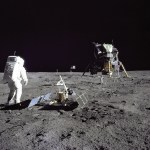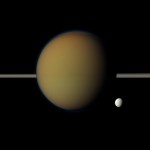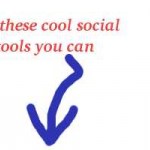Aside from the actual science, I am learning that 1) Copenhagen can be quite cold in the summer and 2) that the natives here are quite friendly. More than once people on the street have stopped to help me find my way. And the streets are full of people -- walking, riding bikes, taking buses. It seems to be a fitting place to have sessions on urban planning. From what I can see, Copenhagen has adopted some of the better ideas.
After a morning of biology, I went for physics and aerospace in the afternoon. The subject was the Google LunarX prize. To get the $20 million, the winning team…
Moon
"There is no dark side of the moon really.
Matter of fact it's all dark."
While the Moon has a nearside and a farside, it does not, actually, have a dark side or a light side, now. At least not a fixed dark side, just a slowly moving night side, and day side.
But it used to. Sorta.
"I remember the first time I saw a globe of the moon as a boy, being struck by how different the farside looks," said Jason Wright, assistant professor of astrophysics. "It was all mountains and craters. Where were the maria? It turns out it's been a mystery since the fifties."
Jason, Arpita Roy a Penn State grad…
"A Hard Rain's A-Gonna Fall on the Dark Side of the Moon..."
The Astrowright has been doing some lunatic slow blogging on an interesting problem:
The Nearside of the Moon
from Ron Hodges - NASA medialibrary
The Farside
from apod
One of these is not like the other...
Jason discusses how we came to be thinking about these things in Part I:
A Hard Rain's A-Gonna Fall on the Dark Side of the Moon I: The Lunar Farside Highlands Problem
It is an interesting problem.
The dichotomy is not superficial
From GRAIL press release 2011
A Hard Rain's A-Gonna Fall on the Dark Side of the Moon II…
“I have announced this star as a comet, but since it is not accompanied by any nebulosity and, further, since its movement is so slow and rather uniform, it has occurred to me several times that it might be something better than a comet. But I have been careful not to advance this supposition to the public.” -Giuseppe Piazzi
So it begins again: the neverending debate about who gets to be a planet and who doesn't. Everyone can bring their own interpretation of the science to the table -- and everyone has their own preferred naming scheme -- but when I think about the Solar System, I try…
"You can't exactly bake a man to your specifications... A hybrid of Einstein, Tarzan and Inge Meysel doesn't exist." -Peer Steinbruck
Of course, if you create enough chances, all the things that could eventually happen will come to pass. This is as true for human beings as it is for the physical Universe. And for our planet, our nearest major neighbor in the Universe -- the Moon -- provides us with a huge variety of sights, if only we're willing to wait.
Image credit: Doug Zubenel.
Every 27.3 days, the Moon makes a complete orbit around the Earth, traveling a full 360° through space.…
"...because today, with cameras as pervasive as they are, there is no such thing really as professional photographers." -Marissa Meyer
Before you get irate, I don't actually agree at all with that quote above; I have no talent for photography at all and a tremendous respect for those who do, and who cultivate it to produce something beautiful. So this weekend, the most appropriate song I could find for you was by a group known as Camera Obscura, and their rather dark ballad,
Your Picture.
Why do I bring up photography today? Because one of my blog's biggest fans, Felicity, runs a…
"It does no harm to the romance of the sunset to know a little bit about it." -Carl Sagan
I would argue the exact opposite, in fact: the beauty of a sunset, in all of its varieties and variations, is only enhanced the more you know about it.
Image credit: Dan Schroeder, via Picasa.
The next time you watch the Sun descend through the sky, towards the horizon, you might marvel at how the Sun remains the same size all the way down. At just slightly over half-a-degree, the Sun appears to drop at a constant rate throughout the afternoon and into early evening.
But there are some small changes…
The cultural critic Walter Benjamin, in his seminal 1936 essay The Work of Art in the Age of Mechanical Reproduction, argued that the "aura" of a work of art, that sense of special awe and reverence we feel, being in its presence, isn't inherent to art itself. Rather, it's a side-effect of its exclusivity, restricted exhibition, authenticity, or perceived value. With the age of "mechanical reproduction" (i.e. printed copies, films, and photographs), that aura disappeared, freeing art from its ties to the bourgeoisie and allowing mass audiences to, in a sense, "own" the work too. Take the Mona…
Ebb and Flow, the Twin Gravity Recovery and Interior Laboratory (GRAIL) Space Ships, which have been employed to provide detailed gravitational mapping of the Moon's geology, have apparently served their purpose and will be reprogrammed in a few hours from now to crash into the moon on Monday.
PASADENA, Calif. -- Twin lunar-orbiting NASA spacecraft that have allowed scientists to learn more about the internal structure and composition of the moon are being prepared for their controlled descent and impact on a mountain near the moon's north pole at about 2:28 p.m. PST (5:28 p.m. EST) Monday,…
"You don't drown by falling in the water; you drown by staying there." -Edwin Louis Cole
Our Solar System is -- at least from our perspective -- the most well-studied system of planets, moons, asteroids and comets in the entire Universe.
Image credit: Olaf Frohn, from earlier in 2012.
And in this system, the closest planet to our Sun, Mercury, was also one of the most poorly understood planets until very recently. Because Mercury is so close to the Sun, it's very difficult to view it under good conditions with a telescope; the risk of ruining your optics by exposing them to direct…
"Summer ends, and Autumn comes, and he who would have it otherwise would have high tide always and a full moon every night." -Hal Borland
Of course you know the danger that would befall us if the Earth ever got too close to the Sun, as the Perry Bible Fellowship shows, atop. But have you ever stopped to think about the Moon in our skies, and what would happen if the Earth and Moon were closer together than they actually are?
Image credit: NASA / Galileo mission.
While photos such as this -- from the Galileo spacecraft -- accurately show the relative size and illumination of the Earth and…
"Nature is relentless and unchangeable, and it is indifferent as to whether its hidden reasons and actions are understandable to man or not." -Galileo Galilei
All of science is rooted in the idea that natural phenomena can be explained naturally, and that if we want to know how anything in the Universe works, all we need to do is ask the Universe the right questions, and the answers will appear.
So what about the question of the night sky, and why it appears to rotate the way it does?
Image credit: Peter Michaud (Gemini Observatory), AURA, NSF.
There are two straightforward…
Yesterday we lost Neil Armstrong, an accidental hero, thrust by fate onto a rock in the sky. Many dreamt of walking on the moon before he did, and a few men did after him. He happened to be the first. Hopefully many more men, and women too, will echo his iconic footsteps in the future. Perhaps even future space tourists will huddle around Tranquility base, laying nostalgic 60s filters over their high-resolution snapshots of an upended American flag from a long-ago mission.
We can only hope. A lot of my favorite humans have died this year: Armstrong, Sally Ride, Ray Bradbury, all people who…
"Geologists have a saying: rocks remember." -Neil Armstrong
Looming up above us, hundreds of thousands of miles away, is the largest moon in the inner solar system: our Moon.
Image credit: © 2004 by Ulli and Christian 'Pete' Lotzmann.
One of the greatest achievements in the history of our planet culminated on July 20th, 1969, when the first creatures from our world set foot on the Moon, becoming -- as far as we know -- the first creatures to ever willingly leave their own world and land on another.
Image credit: NASA, of Neil Armstrong's descent towards the lunar surface.
The honor of the…
"Ignignokt: Well well, I know that. I said that, but it's his nap time now.
Err: 'Cause he like, sleeps during the day.
Ignignokt: But at night he feeds.
Err: And it's always night on the Moon!
Ignignokt: Don't f*** with me, Err." -Aqua Teen Hunger Force, Moon Master
Ahh, the Moon. The brightest object in our night sky is familiar to all inhabitants of Earth, and during its full phase, easily outshines everything else in the night sky, combined.
Image credit: Furious Photos -- Amazing pictures by a delusional hack.
Capable of casting strong shadows, and easily…
"The achievements of Apollo were so bold and our subsequent efforts so timid that the energy of those years seems like a youthful dream." -Buzz Aldrin
43 years ago today, humanity took our first steps on another world, venturing nearly 400,000 kilometers from home and walking on the surface of the Moon.
Image credit: NASA, Apollo 11, photo by Neil Armstrong.
Of course, what we found there was a world whose soil was very similar to our own, but devoid of any atmosphere, liquid, or signs of life, present or past. But out beyond the Moon, visible in the distance even when viewed from Earth,…
"For most of the history of our species we were helpless to understand how nature works. We took every storm, drought, illness and comet personally. We created myths and spirits in an attempt to explain the patterns of nature." -Ann Druyan
Here on Earth, we are well aware of how devastating storms can be. From hurricanes to flash floods, an unpredictable change in weather can turn a serene setting into a catastrophe in no time at all. The clouds that fill the skies can often portend what type of weather is coming, and to me, the most impressive and fearsome of all is the rare and remarkable…
"Building one space station for everyone was and is insane: we should have built a dozen." -Larry Niven
Here on the solid ground of the Earth, the Sun and Moon rise and set on a daily basis. During the hours where the Sun is invisible, blocked by the solid Earth, the stars twirl overhead in the great canopy of the night sky.
Image credit: Chris Luckhardt at flickr.
In the northern hemisphere, they appear to rotate around the North Star, while in the southern hemisphere, the stars appear to rotate about the South Celestial Pole. The longer you observe -- or for photography, the longer you…
"The moon shuts off the beams of the sun as it passes across it, and darkens so much of the earth as the breadth of the blue-eyed moon amounts to." -Empedocles, ~450 B.C.
Less than two weeks ago, I saw my first annular eclipse, with some spectacular results at the moment of maximum eclipse.
From my first eclipse expedition, to False Klamath Cove, on the coast in northern California.
This happens, of course, because -- from our point of view -- the Moon appears to pass in front of the Sun, blocking a fraction of the light coming from it.
Image credit: NASA / Solar Dynamics Observatory.
And…
I remember my first solar eclipse. I was a kid, and it was the one Carlie Simon sang about, in March 1970.
(The eclipse reference is just past three minutes. Some other time we can argue over whether or not Carlie, singing in this video on Martha's Vineyard, was referring to the March 1970 eclipse or the July 1972 eclipse, but I'm sure it was the former, because that's the one everybody got all excited about.)
I was such a geek that I actually missed the eclipse because I was busy collecting data. There was a phone number you could call and a lady's voice would give you the time and…
















